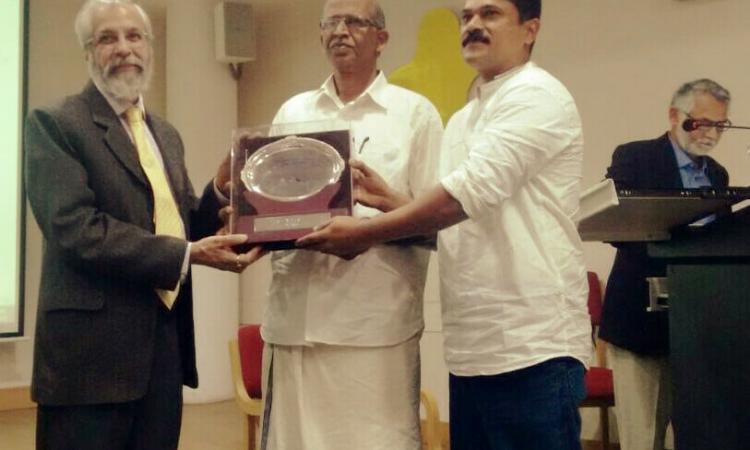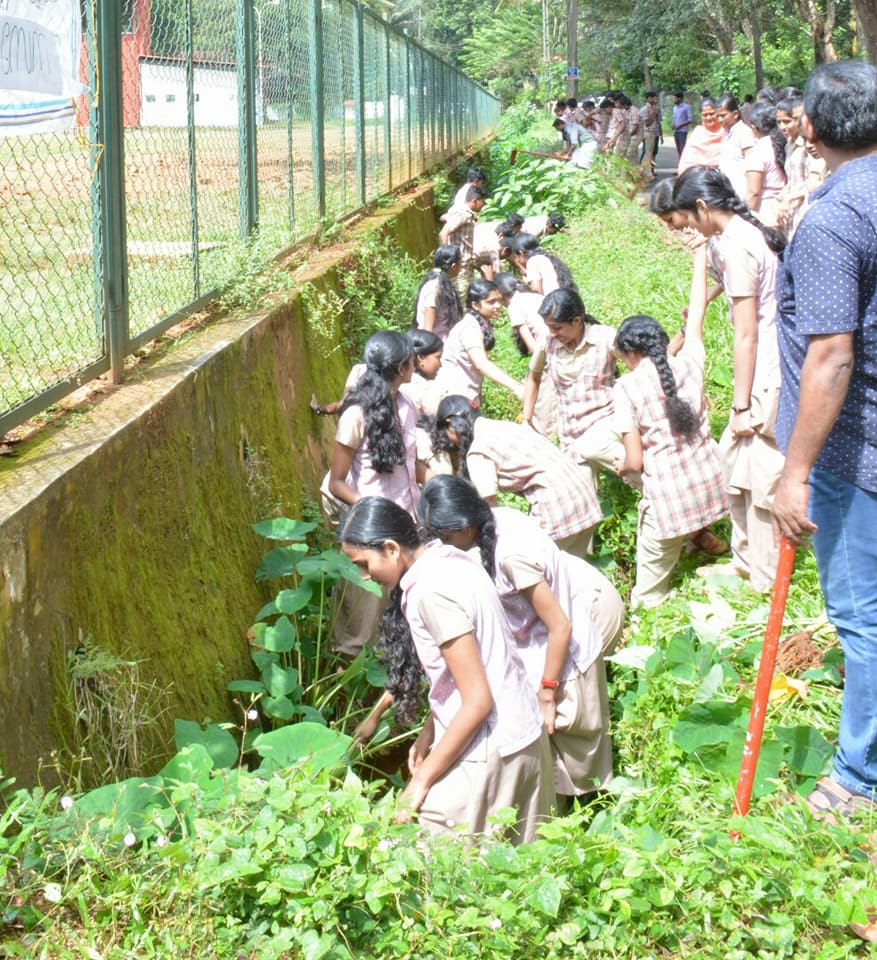
The scenic sublimity of the Meenachil river is immortalised by Arundhati Roy in her Booker prize-winning novel, The God of Small Things. Roy skilfully presents the river flowing through the Aymanam village as a victim of human greed and callousness. The river is described in the book as a beautiful one that turns an ugly waste dump into which anything could be flung. Meenachil is referred to as a swollen sluggish drain carrying all the waste of Kottayam (a town by the river in Kerala) in its arms as it makes its tired way to the sea.
I was reminded of this imagery of the river and the countryside when the Meenachil Nadee Samrakshana Samithi, Kottayam, a voluntary river protection group got felicitated at the India Rivers Day, 2017. The river protection group was given the Bhagirath Prayas Samman for its exemplary work at the grassroots to outline the threats to the river basin, mobilise the local community as well as the political and state agencies to work on the Meenachil river protection issue.
Threats to the river
Meenachil, a 78-kilometres-long river formed by several streams and brooks, originates from the Western Ghats and straddles through the Kottayam district of Kerala. The river empties itself into the Vembanad Lake at Kumarakom, known to be a tourist spot. The region that once grew food crops like paddy and tapioca has increasingly seen the cultivation of cash crops like rubber, black pepper and vanilla. This has altered the ecology of the entire river basin. “The samithi had started a public movement to protect the Meenachil river from sand mining, dam, deforestation and pollution,” says S. Ramachandran, president of Meenachil Nadee Samrakshana Samithi in Kottayam. He was speaking at the India Rivers Day.
Ramachandran has, in the past, served as the president of the All Kerala River Protection Council, a state-wide river protection group. “The council was set up at Aluva back in 1998 by a group of environmental activists who were distressed by the poor state of rivers,” says Ramachandran.

The All Kerala River Protection Council has been of the view that the rivers in particular and the environment in general, have been facing the stress and strain from a persistently high density of population of Kerala during the past three decades or more. Added to this, is the particular settlement pattern, whereby people are scattered over the entire land area. This has resulted in increased human activities and consequent production of waste everywhere. “To add to all these is the high consumption style of living by the people of the state since 1980s, contributed by the inflow of remittances from the emigrants to the Gulf countries,” says Ramachandran.
Like most other rivers in Kerala, “Meenachil too has been reduced to a sluggish drain into which effluents from the factories on its banks as well as urban and domestic waste from urban centers like Erattupetta, Pala, Ettumanoor and Kottayam are conveniently dumped. The river flows only during the monsoon. Pernicious variety of species that frequent swamps and marshes grow in the river. The catchment of the river has been denuded by the indiscriminate felling of trees,” says Eby Emmanuel, secretary, Meenachil Nadee Samrakshana Samithi.
“Meenachil is also known for the traditional boat races organised by clubs with fishermen and farmers as its members. The river is not only used by farmers for agriculture but it also plays a key role in shaping the water bodies in and around Kottayam towards the western coast and the backwaters. The river surges the nearby low lying areas during the monsoons but turns into a dry bed in summers causing an acute shortage of water,” adds Ramachandran.
“Legal and illegal sand mining continues unchecked in the river causing groundwater depletion in the basin. Illegal fishing is another problem we face. The river is the only one in Kerala that is marked by the presence of human settlement all along its stretch, adversely impacting the river and the river basin. The Idukki dam on the upper reaches of the river too reduced the river flow below the dam and at certain stretches, the water lies stagnant and polluted. Barrages and spillways that were constructed to prevent seawater ingress have destroyed the health of the rivers,” says Emmanuel.
The account of the river by the Meenachil Nadee Samrakshana Samithi is also similar to the one by Arundhati Roy who describes the Meenachil that Rahel sees after 23 years:
“Despite the fact that it is June and raining, the river is no more than a swollen drain now. A thin ribbon of thick water that lapped wearily at the mud banks on either side, sequinned with the occasional silver slant of a dead fish. Once it had the power to evoke fear. To change lives. But now its teeth were drawn, its spirit spent. It was just a slow, sludging green ribbon lawn that ferried fetid garbage to the sea…”
The samithi intervenes
While the author stirred the reader’s conscience to preserve the harmonious relationship between the river and the people, community organisations on the ground have worked on improving the countryside and the river. The Meenachil Nadee Samrakshana Samithi was set up by a group of like-minded individuals concerned about the river and has, over the years, shown its serious commitment through activities on dealing with river pollution caused by industries.

In 1989-1990, a group of people came together and opposed a dam planned on the Meenachil river in Teekoy gram panchayat in Kottayam on the grounds that it was ecologically unviable. This group then galvanised into the Meenachil Nadee Samrakshana Samithi which went on to do good work in protecting the river without any external funding. The samithi conducted a campaign in 1995 that enabled the construction of check dams at Erattupetta, Poonjar, Teekoy--the key tributaries of the Meenachil river--to recharge the basin's aquifers.
The samithi successfully involved children in campaigns for the revival and the protection of their river. It has also worked on spreading water literacy among the community. In 2014, the samithi set up Kaval Maadams or resident vigil groups comprising local stakeholders. They organised Kaval Sabhas to discuss the threats to the river, actions needed and taken. They went on to protect small stretches of about 2 kms of the river.
Emmanuel says, “In the case of Meenachil, the samithi put up resistance against sand mining. The official rules related to sand mining were ineffective and the rampant removal of sand was taking place at several stretches of the river leading to ecological imbalance. The river banks are no longer suitable for cultivation of crops as tonnes of wastes are dumped into it.
“The samithi had to intervene in opposing pollution as this was important not just for the conservation of the river but also for protecting the Vembanad wetlands. The Ministry of Environment and Forests has declared Vembanad as a Ramsar site of international importance considering the significance of the wetland system. Further, it has been included in the national wetland conservation plan. Considering this, the protection of the ailing Meenachil river that drains into the lake is necessary for conserving the wetland system,” says Emmanuel.
The activities undertaken by the samithi include the celebration of river day, nadee sandesha yatra, litigations, street plays, documentaries and padayatras. Stakeholders involved include gram panchayats, zilla panchayats, department of local self-governance, college students and the community at large. Some of its innovative campaigns include ‘Give our Meenachil back’ and ‘We can bring our Meenachil back to life’”.
“The samithi’s work is exemplary for its unique ways in combining education, campaigns and local action, without any external funding, leading to local ownership and collaboration to achieve scale for change and tangible impact,” says the award citation.
Till the government steps in to protect the Meenachil, the samithi is all geared up to re-establish the hydrological and ecological links of the river.
/articles/meenachil-river-warriors-shine